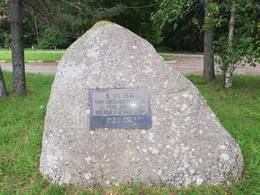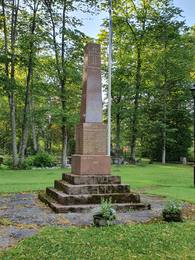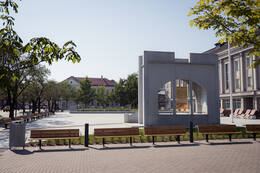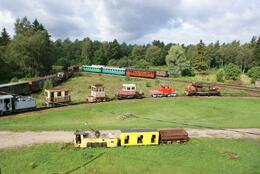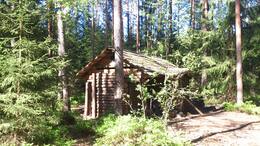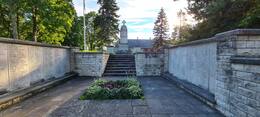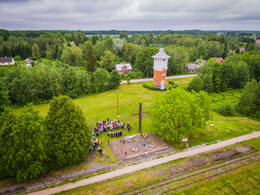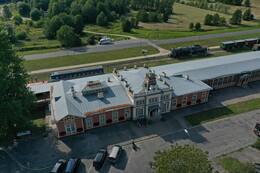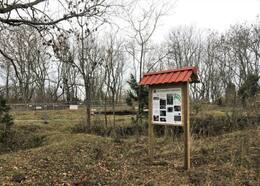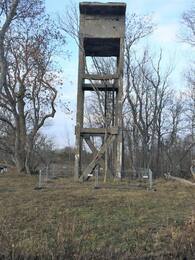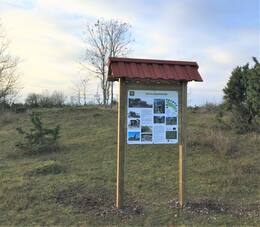Nepriklausomybės karo atminimas Vakarų Estijoje
Timmkanal battle site
On 4 July 1941, Forest Brothers stormed the executive committee in Häädemeeste. The group was led by Elmar Toomingas, the headmaster of Metsapoole Primary School and the head of the Häädemeeste regional unit of the Defence League.
On 6 July, a Red Army destruction battalion arrived: some of them were killed, others were taken prisoner.
On 7 July, a combined force of 400 men from Red Army infantry and destruction battalions attacked the local militia, which comprised 60 men. The defenders, with the help of two light tanks, were pushed back to Timmkanal, where they reorganised and took up positions again.
On 8 July, the destruction battalion burnt down 14 farmsteads and the schoolhouse in the village of Rannametsa and the church in Võiste. A battle ensued in Tahkuranna between the advancing Germans and the destruction battalion leaving Rannametsa, which suffered the loss of 57 men, with eight captured. Some sources claim the German unit was the 402nd Cyclist Battalion led by a Major Ullersperger. The Estonian and German units arrived in Pärnu that afternoon. The battle site is marked by a granite boulder adorned with a black tablet that reads: "On 8 July 1941 the destruction battalion of Pärnu burnt down 18 households and the schoolhouse in Rannametsa". The text is followed by a quote from a poem by Hando Runnel.
Monument to the War of Independence in Pärnu-Jaagupi
In 1922, a monument dedicated to the men from Pärnu-Jaagupi parish (in what is now Põhja-Pärnumaa municipality) who fought in World War I and the War of Independence was unveiled in the cemetery in Pärnu-Jaagupi. The monument was made at Jüri Walk's marble and granite factory in Pärnu. It was unveiled on 22 September 1922 and demolished in 1945. By 1 May 1989, a total of 10,362 roubles had been raised in donations for the restoration of the monument, which was unveiled anew on 18 June 1989. The monument comprises a multi-layered obelisk on a four-stepped base. The gilded contours on the front of the obelisk depict the Cross of Liberty. Below it is the text: "Be ye faithful unto death". The bottom plinth of the obelisk is adorned with a gilded list of the dead entitled ‘To the fallen heroes of Jakobi’.
Estijos Respublikos Nepriklausomybės paskelbimo paminklas
This monument is situated on Independence Square in the centre of Pärnu.
Made from granite and designed by Kaarel Eelma, Mart Aas and Mikk Mutso, it was unveiled in 2008 near the former site of the Endla Theatre.
On 23 February 1918 the Manifesto to the Peoples of Estonia was publicly declared for the first time from the balcony of said theatre, which was badly damaged in World War II and later demolished.
The monument depicts the balcony of the historical theatre in its original size. It displays the text from the manifesto in both the original blackletter typeface and Antiqua, as well as in Braille.
The manifesto was published and the Republic of Estonia declared in the capital Tallinn on 24 February, transferring all authority to the Estonian Salvation Committee, later followed by the Provisional Government. 24 February 1918 is celebrated to this day as the anniversary of the Republic of Estonia.
Estijos geležinkelių muziejus Lavasare
The Estonian Museum Railway is situated on the old peat industry site in Lavassaare, 17 km north-east of Pärnu.
The museum is the only narrow-gauge railway museum in the country, displaying, among other exhibits, a functioning steam locomotive. It has in its collection over 80 railroad cars, including five locomotives and a variety of technical apparatus, most of it on display outdoors. The peat workers’ residential building on the museum premises houses an indoor exhibition displaying over 700 historical photos, items and documents related to narrow-gauge railways in Estonia.
The narrow-gauge network in the Governorates of Estonia and Livonia was established during the 19th and 20th centuries for the development of regional industry.
Pragaro dugno (Põrgupõhja) bunkeris
Põrgupõhja Bunker is situated in the woods near the village of Tiduvere in Rapla County.
By 1945 anti-Soviet dissent had developed into organised resistance movements in many occupied lands, including Estonia. Attempts were made to unify fighter groups and establish a network. This bunker, built in 1947, was an important stronghold for the Forest Brothers.
Fully reconstructed, Põrgupõhja Bunker was opened in 2015, showcasing the everyday life of the Forest Brothers. Anyone interested can spend the night in the bunker and imagine what it must have been like to live in hiding.
Adjacent to it is the original site of the bunker, which was destroyed by the NKVD on 31 December 1947, plus its surrounding dirt wall and a memorial to the fallen Forest Brothers.
Monument to the War of Independence in Kullamaa
This monument, made from Saaremaa dolomite, was unveiled on 11 July 1926. It was situated on a square near the church in Kullamaa, where the memorial to well-known Estonian composer Rudolf Tobias now stands. It was destroyed in 1945 and unveiled anew on 30 September 1989. The current location of the monument is between the former pastorate and the church. The monument comprises a tapered obelisk of both protruding and receding blocks on a stepped footing with a Cross of Liberty on top. The second stage of the memorial was added between 1991 and 1999: a nine-step staircase up to a platform surrounded by roughly finished limestone walls. It stands out from other memorials to the War of Independence due to the fact that after its restoration, tablets in memory of the people killed during the Red Terror and World War II were added to the memorial. The stairs leading to the monument are surrounded by walls listing the names of the more than 300 dead.
‘Railway Tracks Remember’ monument to those deported from West-Estonia
This monument is situated in the small borough of Risti, next to its railway station.
Designed by Viljar Ansko, the monument was unveiled in 1999 and is dedicated to all of those deported from Western Estonia.
Risti station, the last stop in Lääne County, was the point from which not only the majority of the people from the local area, but also those from Pärnu and Rapla counties and the islands of Hiiumaa and Vormsi were deported to Siberia. A total of 3000 deportees passed through here along with people arrested in Lääne County. The 13-metre monument is mounted on a small railway platform with stone stairs at both ends. Four rails rise up into the air from the platform, which are bound together by a double cross made from rails. Aside from commemorating the mass oppression of the recent past, the cross also represents the history of Risti as a railway settlement.
Hapsalu geležinkelių ir susisiekimo muziejus
This museum is housed in a train station built in the early 20th century to service the railway line connecting to the resort in Haapsalu.
Opened in 1997, the museum showcases the one-and-a-half centuries of development of Estonian railways and mediums of communication. Besides decommissioned locomotives, the museum displays an affable station master and an Ericsson Skeleton Type telephone and invites visitors to the station's post office.
The outdoor exhibition also displays a World War II steam locomotive 52 3368.
The steam locomotive 52 3368, initially numbered 16494, was completed in April 1943 in Munich at the Krauss-Maffei Works and then transported to Austria, the Bruck an der Mur depot of the Villach division. The Hungarian State Railways (MAV) rented the locomotive and on June 7, 1945, it was captured by the Red Army. When the Hungarian-Romanian border was altered, locomotive 52 3368 was given to the Romanian railway (CFR). In August 1950, at the CFR Iași Works the locomotive was converted to broad gauge (5 ft) and given to the Soviet Union, where it operated at the Kotovsk and Vapnyarka depot of the Odessa Railway from October 1950 to 1956. After that, the Ministry of Transportation of the USSR kept it in the strategic reserve. On August 26, 1957, the locomotive TE-3368 (ТЭ-3368, the class 52 was renamed as TE in 1952) arrived at the Valga locomotive base. There the loco got another tender (so-called Wannentender), built in 1943 by Borsig Works in Berlin and formerly belonging to locomotive TE-450. It could carry 32 m3 of water and 10 tonnes of fuel. The locomotive stayed in Valga (from 1961 to 1968 shortly in Tartu) until the base was closed in 1997. From 1950 to 1985, its kilometrage as a broad-gauge locomotive was 463,216 kms. On May 8, 1998, the steam locomotive was delivered to Haapsalu to be exhibited at the Railway Museum.
The class 52 war locomotive was designed in a hurry in June 1942 on request of the Reich´s Ministry of Armaments and War Production in the example of the class 50 locomotive. The 2-10-0 type engine had a power of about 1,500 hp and a maximum speed of 80 km/h. It had a simplified and light design (15-ton axle load) with an intended life-span of 5 years. From 1942 to 1945, a total of 6,295 locomotives of that class were built in 14 factories across Europe. After World War II, the class 52 locomotives had spread all over Europe, from Norway to Turkey and from Belgium to the Soviet Union. There were over 2,000 locomotives in the USSR – the exact number remains unknown, as the locomotives were subject to different authorities, including security authorities. In Estonia, the class 52 steam locomotives ran first on standard-gauge (1,435 mm) lines in 1943–44. Since 1953, when they replaced the American class ShA war locomotives (the Shariks) in Estonian freight traffic, 138 class TE (52) regauged locos have been here. By 1991, only one remained in Estonia – the TE-3368.
180-mm battery on Osmussaar (north)
The island of Osmussaar is situated off the north-west coast of Estonia. This 180-mm coastal battery is located, in turn, in the north-western part of the island.
The battery comprised two twin 180-mm guns. Some sources state that the battery was ready for combat by 1 September 1941, four months ahead of schedule. Others claim that only the 180-mm gun facility to the south had been set up by this time. The fact that the gun to the north was seldom used is confirmed by its ammunition stock being more full than that of the gun to the south. In September 1941 a military hospital was established in the northern facility. It contains over one hundred beds. The hospital’s outhouse was built next to the tower from red brick. Both gun facilities were blown up during the retreat from Osmussaar in December 1941. Its turrets were turned into scrap in 1945.
The gun structure is in better condition at the northern facility, bearing less damage than its counterpart to the south. The water level varies in the battery, but the upper floor is accessible.
Spitham Radar Station
This military outpost is situated in the village of Spitham in Lääne-Nigula municipality on the Gulf of Finland.
Construction of the outpost began in 1958. It is assumed that the military unit from Osmussaar was relocated here. Tents were used prior to the completion of the barracks, with senior officers accommodated on local farms. Barracks, a canteen and technical facilities were built. Its diesel power generator also provided electricity to the village. In 1993 the military unit was relocated to Leningrad oblast in Russia.
Two large radar mounds, a command centre, multiple technical bunkers, a garage for transporting equipment, a couple of pillboxes and some ruins remain of the radar station. Only the crumbling canteen remains of its residential quarters.
Osmussaar fire control tower
The island of Osmussaar is situated off the north-west coast of Estonia. This fire control tower is located, in turn, in the north-western part of the island.
The whole island was annexed for the use of the Soviet Army, with a signal unit stationed there. The island was claimed under the Mutual Assistance Pact in 1940, forcing the locals to leave. Of all the intricate coastal defences planned on the island in 1940, only two batteries and an underground ammunition storage were ever built. The 13-metre fire control tower (or range finding tower) was completed in 1941. Germans bombed the island from the batteries set up in Põõsaspea. The upper platform of the tower was hit in November, damaging the range finder. It was replaced with a 3-metre range finder brought from the reserve fire control tower set up in the lighthouse. The reinforced concrete pillars which were hit have been repaired in certain places.
The reinforced concrete pillars are currently exposed.
180-mm battery on Osmussaar (south)
The island of Osmussaar is situated off the north-west coast of Estonia. This 180-mm coastal battery is located, in turn, in the north-western part of the island.
The battery comprised two twin 180-mm guns. Some sources state that the battery was ready for combat by 1 September 1941, four months ahead of schedule. Others claim that only the 180-mm gun facility to the south had been set up by this time. The fact that the gun to the north was seldom used is confirmed by its ammunition stock being more full than that of the gun to the south. In September 1941 a military hospital was established in the northern facility. It contains over one hundred beds. The hospital’s outhouse was built next to the tower from red brick. Both gun facilities were blown up during the retreat from Osmussaar in December 1941. Its turrets were turned into scrap in 1945.
The gun structure is in better condition at the northern facility, bearing less damage than its counterpart to the south. The water level varies in the battery, but the upper floor is accessible.
130-mm battery on Osmussaar (middle)
The island of Osmussaar is situated off the north-west coast of Estonia. This 130-mm coastal battery is located, in turn, in the north-western part of the island.
Construction began in 1940, but experienced disruptions. The artillery only arrived a couple days after war broke out and was hastily put in place, with installation completed by 3 July 1941. Since the island’s 180-mm battery only became battle-ready that September, the 130-mm battery and 76-mm air-defence guns were the only firepower on Osmussaar for the first two months of the war. Both ships and aircraft were fired at. In early December, during the evacuation of the island, the artillery was rendered unusable. From 1942-1944 the Germans had their own artillery mounted on the 130-mm gun pits. In autumn 1944 restoration work began on the battery. It has been speculated that the battery was demolished in the 1950s; the exact date is unknown.
Three overgrown gun pits and a partly collapsed dugout are all that remain of the battery.




